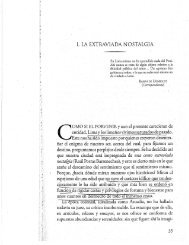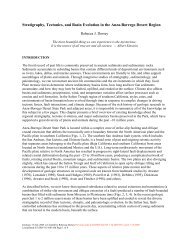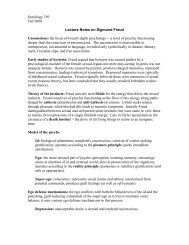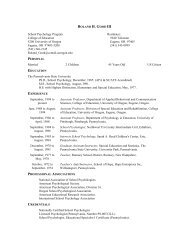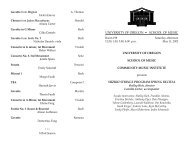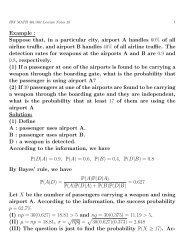Chapter 6 – Statement of Cash Flows
Chapter 6 – Statement of Cash Flows
Chapter 6 – Statement of Cash Flows
Create successful ePaper yourself
Turn your PDF publications into a flip-book with our unique Google optimized e-Paper software.
<strong>Chapter</strong> 6 <strong>–</strong> <strong>Statement</strong> <strong>of</strong> <strong>Cash</strong> <strong>Flows</strong><br />
The <strong>Statement</strong> <strong>of</strong> <strong>Cash</strong> <strong>Flows</strong> describes the cash inflows<br />
and outflows for the firm based upon three categories <strong>of</strong><br />
activities.<br />
Operating Activities: Generally include transactions in the<br />
“normal” operations <strong>of</strong> the firm.<br />
Investing Activities: <strong>Cash</strong> flows resulting from purchases<br />
and sales <strong>of</strong> property, plant and equipment, or securities.<br />
Financing Activities: <strong>Cash</strong> flows resulting from<br />
transactions with lenders and owners.<br />
• Funds received from lenders<br />
• Payments to lenders (not interest)<br />
• Contributions <strong>of</strong> capital from owners (sales <strong>of</strong> stock)<br />
• Dividend payments
The Direct Method<br />
The direct method lists the individual sources and uses <strong>of</strong><br />
cash. Typical line items include cash received from<br />
customers, cash paid to suppliers, cash paid for wages, etc.<br />
Consider E3-18<br />
Popovich Co. had the following transactions during June.<br />
a. $20,000 <strong>of</strong> supplies were purchased with cash<br />
b. $6,000 <strong>of</strong> supplies were consumed.<br />
c. $60,000 <strong>of</strong> merchandise was sold. 40% <strong>of</strong> the sales<br />
were on credit. The merchandise cost Popovich<br />
$28,000.<br />
d. $200,000 was borrowed from a bank<br />
e. Interest <strong>of</strong> $2,000 was incurred and paid<br />
f. $100,000 <strong>of</strong> equipment was purchased by issuing a<br />
note payable.<br />
g. $4,000 <strong>of</strong> equipment value was consumed.
We could construct the following statement <strong>of</strong> cash flow:<br />
<strong>Cash</strong> Flow from Operations:<br />
<strong>Cash</strong> received from customers $36,000<br />
<strong>Cash</strong> paid for supplies (20,000)<br />
<strong>Cash</strong> paid for interest (2,000)<br />
<strong>Cash</strong> provided by operations 14,000<br />
<strong>Cash</strong> flow for investments 0<br />
<strong>Cash</strong> flow from financing activities:<br />
New bank borrowings $200,000<br />
Net cash flow $214,000<br />
The problem is that these items do not come from the<br />
general ledger. There is no account for “cash received<br />
from customers”, or “cash paid for supplies”. Instead, you<br />
would have to infer the amount from the firm’s accounting<br />
system.
For example, assume the following data from the firm’s<br />
accrual based accounting system (all sales are credit sales);<br />
Accounts Receivable 1/1/00 $400,000<br />
Accounts Receivable 12/31/00 $450,000<br />
2000 Sales $3,000,000<br />
How much cash did the firm receive from customers?<br />
First, consider the entries used to record credit sales and the<br />
collection <strong>of</strong> cash.<br />
Dr. Accounts Receivable<br />
Cr. Sales<br />
Dr. <strong>Cash</strong><br />
Cr. Accounts Receivable<br />
Debits to accounts receivable result from sales transactions,<br />
and the credits result from cash collections.
Therefore:<br />
Beginning Accounts Receivable<br />
+ Credit Sales<br />
- <strong>Cash</strong> Received<br />
= Ending Accounts Receivable<br />
OR<br />
<strong>Cash</strong> Received = Beg. AR + Credit Sales <strong>–</strong> Ending AR.<br />
Define ΔAR = Ending AR <strong>–</strong> Beginning AR, where Δ means<br />
the change in the account balance, then:<br />
<strong>Cash</strong> Collections = Credit Sales <strong>–</strong> ΔAR.<br />
In our example,<br />
<strong>Cash</strong> collections = $3,000,000 - $50,000 = $2,950,000.<br />
There was a total <strong>of</strong> $3,000,000 in sales, but not all <strong>of</strong> it<br />
was collected in cash. Because there was an increase in<br />
AR, the cash received was less than total sales.
We can use a similar approach to go from cost <strong>of</strong> goods<br />
sold to cash payments. The balance sheet account affected<br />
by cost <strong>of</strong> goods sold is inventory. Because inventory is<br />
usually purchased on account, we also need to consider<br />
accounts payable.<br />
Beginning Inventory Beginning Accounts Payable<br />
+ Purchases + Purchases<br />
- Cost <strong>of</strong> Goods Sold - Payments<br />
= Ending Inventory = Ending Accounts Payable<br />
Δ Inventory = Ending Inventory <strong>–</strong> Beginning Inventory<br />
Δ Accounts Payable = Ending AP <strong>–</strong> Beginning AP<br />
COGS = Purchases <strong>–</strong> Δ Inventory<br />
Payments = Purchases <strong>–</strong> ΔAP<br />
Purchases = ΔAP + Payments<br />
COGS = ΔAP + Payments <strong>–</strong> Δ inventory<br />
Payments = COGS + Δ inventory <strong>–</strong> ΔAP
Direct Method Example<br />
ABC Co. Balance Sheets<br />
Account 2000 1999<br />
<strong>Cash</strong> $100,000 $130,000<br />
Accounts Receivable 420,000 460,000<br />
Inventory 800,000 700,000<br />
Prepaid Rent 70,000 50,000<br />
PP & E 1,000,000 800,000<br />
Total Assets $2,390,000 $2,140,000<br />
Accounts Payable $300,000 $360,000<br />
Accrued Wages 175,000 120,000<br />
Stockholders Equity 1,915,000 1,660,000<br />
Total Liab & S.E. $2,390,000 $2,140,000<br />
ABC Co.’s Income <strong>Statement</strong><br />
2000<br />
Sales $5,000,000<br />
Cost <strong>of</strong> Goods Sold 3,500,000<br />
Gross Margin $1,500,000<br />
Rent Expense $240,000<br />
Wage Expense 800,000<br />
Depreciation Expense 150,000<br />
Net Income $310,000
<strong>Statement</strong> <strong>of</strong> <strong>Cash</strong> <strong>Flows</strong> Direct Method Example<br />
Assume that accounts payable was only used to acquire<br />
inventory. Use the preceding information to compute the<br />
following:<br />
1. <strong>Cash</strong> Received from Customers.<br />
Sales − ΔAR<br />
5,000,000 <strong>–</strong> (-40,000) = 5,040,000<br />
2. <strong>Cash</strong> Paid to Suppliers for Inventory<br />
COGS + ΔInventory − ΔAP<br />
3,500,000 + 100,000 <strong>–</strong> (-60,000) = 3,660,000<br />
3. <strong>Cash</strong> Paid to Landlords<br />
Rent Expense + ΔPrepaid rent<br />
240,000 + 20,000 = 260,000<br />
4. <strong>Cash</strong> Paid to Employees<br />
Wage expense <strong>–</strong> ΔAccrued wages<br />
800,000 <strong>–</strong> 55,000 = 745,000<br />
2000<br />
<strong>Cash</strong> received from customers 5,040,000<br />
<strong>Cash</strong> paid to suppliers -3,660,000<br />
<strong>Cash</strong> paid to landlords -260,000<br />
<strong>Cash</strong> paid to employees -745,000<br />
<strong>Cash</strong> flows from operations 375,000
<strong>Statement</strong> <strong>of</strong> <strong>Cash</strong> <strong>Flows</strong>: Indirect Method<br />
The indirect method uses changes in balance sheet accounts<br />
to reconcile net income to cash flows from operations.<br />
Assets = Liabilities + Stockholders Equity<br />
<strong>Cash</strong> + Noncash Assets = Liabilities + SE<br />
<strong>Cash</strong> = L + SE <strong>–</strong> NCA<br />
Δ <strong>Cash</strong> = ΔL + ΔSE <strong>–</strong> ΔNCA<br />
This means that we can evaluate changes in cash by<br />
looking at changes in balance sheet accounts.<br />
We can adjust this further by noting that<br />
ΔSE = NI <strong>–</strong> Dividends<br />
Δ <strong>Cash</strong> = ΔL + NI <strong>–</strong> Dividends <strong>–</strong> ΔNCA<br />
To get cash flows from operations we start with net income<br />
and adjust for changes in current assets and current<br />
liabilities.
<strong>Statement</strong> <strong>of</strong> <strong>Cash</strong> <strong>Flows</strong> Indirect Method<br />
The operating cash flow section <strong>of</strong> the <strong>Statement</strong> <strong>of</strong> <strong>Cash</strong><br />
<strong>Flows</strong> using the indirect method has the following form:<br />
Net Income<br />
+ Depreciation Expense<br />
- Δ Current Assets (minus increases, plus decreases)<br />
+ Δ Current Liabilities (plus increases, minus decreases)<br />
= <strong>Cash</strong> flows from operations<br />
Following the previous example, we would have:<br />
2000<br />
Net Income $310,000<br />
Depreciation Expense 150,000<br />
- Δ Accounts Receivable 40,000<br />
- Δ Inventory (100,000)<br />
- Δ Prepaid Rent (20,000)<br />
+ Δ Accounts Payable (60,000)<br />
+ Δ Accrued Wages 55,000<br />
<strong>Cash</strong> <strong>Flows</strong> From Operations 375,000<br />
Note that you get the same cash flow from operations under<br />
both methods. However, the information provided in the<br />
details is substantially different.
Investing and Financing <strong>Cash</strong> <strong>Flows</strong><br />
Once we have computed the cash flows from operations we<br />
need to complete the sections on investing and financing<br />
cash flows. In general this is fairly simple. Investing cash<br />
flows include purchases <strong>of</strong> long-term assets and proceeds<br />
from the disposal <strong>of</strong> long-term assets. Financing cash<br />
flows include proceeds from the issuance <strong>of</strong> long-term debt<br />
or capital stock, repayments <strong>of</strong> long-term debt, repurchases<br />
<strong>of</strong> capital stock and dividends.
Sample Problem: Use the following data to construct a<br />
statement <strong>of</strong> cash flows using the direct and indirect<br />
methods. 2000 1999<br />
<strong>Cash</strong> $4,000 $14,000<br />
Accounts receivable 25,000 32,500<br />
Prepaid insurance 5,000 7,000<br />
Inventory 37,000 34,000<br />
Fixed assets 316,000 270,000<br />
Accumulated Depreciation (45,000) (30,000)<br />
Total assets 342,000 327,500<br />
Accounts payable $18,000 $16,000<br />
Wages payable 4,000 7,000<br />
Note payable 173,000 160,000<br />
Capital stock 88,000 84,000<br />
Retained earnings 59,000 60,500<br />
Total Liabilities & Equity 342,000 327,500<br />
2000<br />
Sales $200,000<br />
Cost <strong>of</strong> goods sold (123,000)<br />
Depreciation expense (15,000)<br />
Insurance expense (11,000)<br />
Wage Expense (50,000)<br />
Net Income 1,000<br />
During 2000 declared and paid dividends <strong>of</strong> $2,500<br />
During 2000, ABC paid $46,000 in cash to acquire new<br />
fixed assets. The accounts payable was used only for<br />
inventory. No debt was retired during 2000.
Direct Method<br />
<strong>Cash</strong> Flow from Operations:<br />
<strong>Cash</strong> received from customers 207,500<br />
<strong>Cash</strong> paid for inventory -124,000<br />
<strong>Cash</strong> paid for insurance -9,000<br />
<strong>Cash</strong> paid for wages -53,000<br />
<strong>Cash</strong> flow from operations 21,500<br />
<strong>Cash</strong> Flow from Investments:<br />
<strong>Cash</strong> paid for fixed assets -46,000<br />
<strong>Cash</strong> flow from financing activities:<br />
<strong>Cash</strong> dividend payments -2,500<br />
Proceeds from issuance <strong>of</strong> note payable 13,000<br />
Proceeds from issuance <strong>of</strong> stock 4,000<br />
<strong>Cash</strong> flows from financing activities 14,500<br />
Net <strong>Cash</strong> Flow -10,000<br />
Beginning <strong>Cash</strong> Balance 14,000<br />
Ending <strong>Cash</strong> Balance 4,000
Indirect Method<br />
<strong>Cash</strong> Flow from Operations:<br />
Net Income 1,000<br />
Depreciation Expense 15,000<br />
Δ Accounts receivable 7,500<br />
Δ Prepaid insurance 2,000<br />
Δ Inventory -3,000<br />
Δ Accounts payable 2,000<br />
Δ Wages payable -3,000<br />
<strong>Cash</strong> Flow from Operations 21,500<br />
<strong>Cash</strong> Flow from Investments:<br />
<strong>Cash</strong> paid for fixed assets -46,000<br />
<strong>Cash</strong> flow from financing activities:<br />
<strong>Cash</strong> dividend payments -2,500<br />
Proceeds from issuance <strong>of</strong> note payable 13,000<br />
Proceeds from issuance <strong>of</strong> stock 4,000<br />
<strong>Cash</strong> flows from financing activities 14,500<br />
Net <strong>Cash</strong> Flow -10,000<br />
Beginning <strong>Cash</strong> Balance 14,000<br />
Ending <strong>Cash</strong> Balance 4,000




